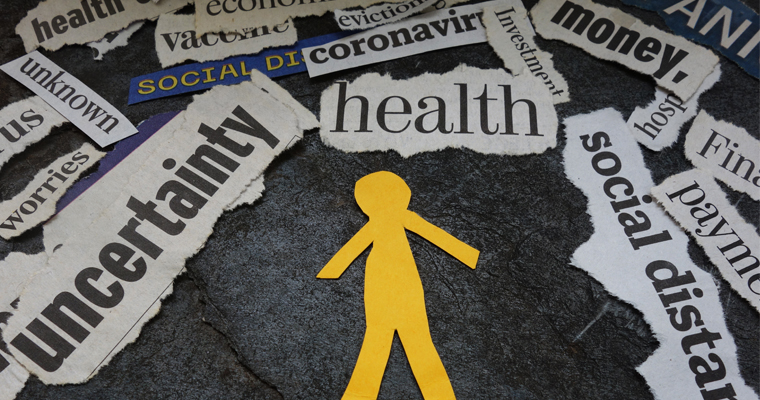Report Finds Disparities in Physical, Mental Health Effects of COVID-19
Sixth Living in Boston During COVID-19 Study Examines Impacts by Race, Ethnicity, Socioeconomic Status

“ These differences suggest targeted ways in which residents might better be supported during the second wave of the pandemic. ”
A newly released report by UMass Boston researchers finds that the coronavirus pandemic has affected Bostonian’s health in multiple ways that vary across differences in race and ethnicity, socioeconomic status, and family composition.
The National Science Foundation-funded Living in Boston During COVID-19: Physical and Mental Health is the sixth in a series of reports analyzing data from a survey conducted last summer by researchers at Northeastern University’s Boston Area Research Initiative, the Center for Survey Research at UMass Boston, and the Boston Public Health Commission. The data presents unique insights into how perspectives and experiences of the COVID-19 pandemic have varied across the populations and neighborhoods of a single city—something not currently available from any other source, in Boston or otherwise.
The report demonstrates how the pandemic has affected the physical and mental health of Boston’s residents by examining how these impacts were distributed in terms of current health and health-related behaviors, as well as in relation to age, race, and ethnicity, socioeconomic and marital status. It reveals stark differences in how different populations have experienced physical and mental health effects during the pandemic, even apart from suffering from COVID-19 itself.
“Declines in both physical and mental health added to the challenges faced by residents struggling with other adverse consequences of the pandemic,” said lead author Professor of Sociology Russell Schutt of UMass Boston. “The likelihood of adverse health effects varied in relation to socioeconomic and family status and in relation to health-related behaviors, as well as by neighborhood. These differences suggest targeted ways in which residents might better be supported during the second wave of the pandemic.”
Key findings of the report include:
- Many residents experienced adverse impacts of the coronavirus pandemic on their health.
- Almost one in ten of survey respondents believed they had had COVID-19, and a quarter had been tested for it.
- At the time of the survey, respondents felt both their physical and mental health had declined during the pandemic.
- Physical and mental health also declined among those questioned both before the pandemic and after it began.
- The likelihood of adverse health impacts of the pandemic varied with health-related behaviors.
- Drinking was associated with worse physical and mental health effects.
- Exercising was associated with less adverse effects on physical health, but not with change in mental health.
- Visiting others was associated with less adverse effects on health—both physical and particularly mental health.
- Adverse health impacts amplified health disparities.
- Those with poorer self-reported health reported more adverse effects of the pandemic on their physical health.
- Those with more symptoms of depression reported more adverse effects of the pandemic on their mental health.
- The likelihood of adverse health effects of the pandemic varied with sociodemographic characteristics.
- More younger residents reported adverse impacts on physical and mental health compared to those 50 and older, but the youngest residents also included the highest proportion who said their physical health had improved.
- White residents were more likely to report adverse health impacts— particularly on mental health—than residents of color.
- Single women were more likely to have experienced adverse health effects—particularly on physical health—compared to married women and to men.
- Those with more education and those who were working at the time of the survey reported more adverse physical and mental health effects than those with less education and those who were not working; adverse mental health effects of working elevated among those working mostly at home.
- There were some differences in adverse health impact between Boston’s neighborhoods.
- Some of the neighborhoods with the highest proportions of residents reporting a decline in their physical health since March tended to have more residents who were poor (North Dorchester, Mission Hill) or young (Fenway/Kenmore).
- Some of the neighborhoods with the highest proportions of residents reporting a decline in mental health tended to have more residents who were White (Beacon Hill) or young (Fenway/Kenmore).
Accompanying the report’s release are data stories summarizing the main findings, which can be found at Adverse Impact on Physical and Mental Health.
The UMass Boston research team also includes Director of the Center for Survey Research Lee Hargraves; Floyd (Jack) Fowler, a senior research fellow at the Center for Survey Research; Anthony Roman, a senior research fellow at the Center for Survey Research; Hannah Grabowski, a research assistant and recent graduate of the Graduate Program in Applied Sociology; and Nikola Kovacevic, assistant study director in the Center for Survey Research.
About UMass Boston
The University of Massachusetts Boston is deeply rooted in the city's history, yet poised to address the challenges of the future. Recognized for innovative research addressing complex issues, metropolitan Boston’s public university offers its diverse student population both an intimate learning environment and the rich experience of a great American city. UMass Boston’s colleges and graduate schools serve more than 16,000 students while engaging local and global constituents through academic programs, research centers, and public service. To learn more, visit www.umb.edu.